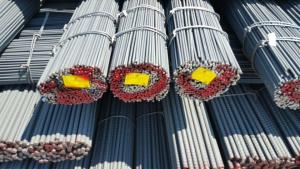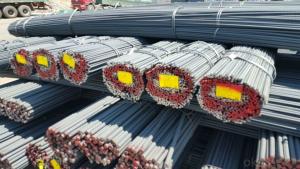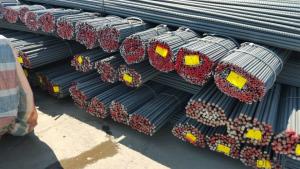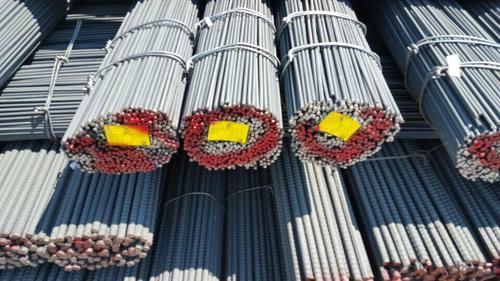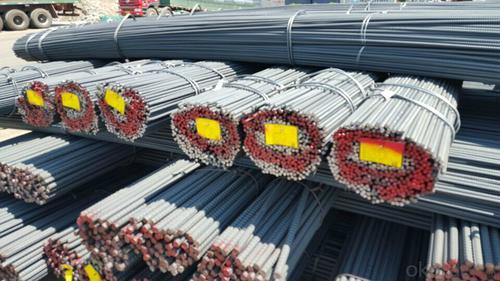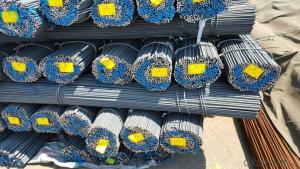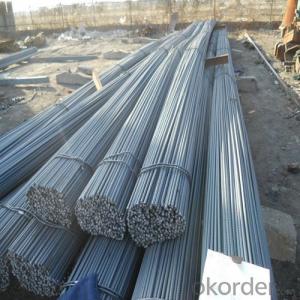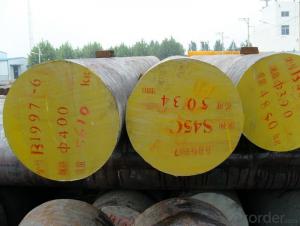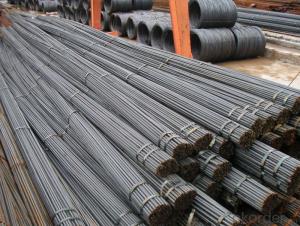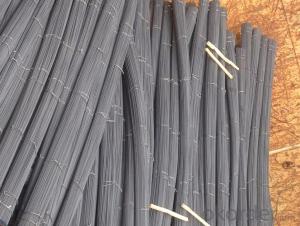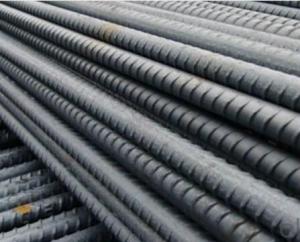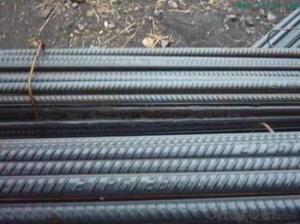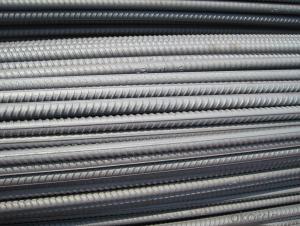Reinforcing Deformed Steel Bars with Grade HRB400
- Loading Port:
- Tianjin
- Payment Terms:
- TT OR LC
- Min Order Qty:
- 25 m.t.
- Supply Capability:
- 20000 m.t./month
OKorder Service Pledge
OKorder Financial Service
You Might Also Like
Specification
OKorder is offering high quality Hot Rolled Rebars at great prices with worldwide shipping. Our supplier is a world-class manufacturer of steel, with our products utilized the world over. OKorder annually supplies products to Africa, North American and Asian markets. We provide quotations within 24 hours of receiving an inquiry and guarantee competitive prices.
Product Applications:
Deformed bar is widely used in buildings, bridges, roads and other engineering construction. Big to highways, railways, bridges, culverts, tunnels, public facilities such as flood control, dam, small to housing construction, beam, column, wall and the foundation of the plate, deformed bar is an integral structure material. With the development of world economy and the vigorous development of infrastructure construction, real estate, the demand for deformed bar will be larger and larger..
Label: to be specified by customer, generally, each bundle has 1-2 labels
Product Advantages:
OKorder's Hot Rolled Rebars are durable, strong, and resist corrosion.
Main Product Features:
· Premium quality
· Prompt delivery & seaworthy packing (30 days after receiving deposit)
· Corrosion resistance
· Can be recycled and reused
· Mill test certification
· Professional Service
· Competitive pricing
Product Specifications:
Manufacture: Hot rolled
Grade: HRB400 – HRB500
Certificates: ISO, SGS, BV, CIQ
Length: 6m – 12m, as per customer request
Packaging: Export packing, nude packing, bundled
Grade | Technical data of the original chemical composition (%) | ||||||
C | Mn | Si | S | P | V | ||
HRB400 | ≤0.25 | ≤1.60 | ≤0.80 | ≤0.045 | ≤0.045 | 0.04-0.12 | |
Physical capability | |||||||
Yield Strength (N/cm²) | Tensile Strength (N/cm²) | Elongation (%) | |||||
≥400 | ≥570 | ≥14 | |||||
Theoretical weight and section area of each diameter as below for your information:
Diameter(mm) | Section area (mm²) | Mass(kg/m) | Weight of 12m bar(kg) |
6 | 28.27 | 0.222 | 2.664 |
8 | 50.27 | 0.395 | 4.74 |
10 | 78.54 | 0.617 | 7.404 |
12 | 113.1 | 0.888 | 10.656 |
14 | 153.9 | 1.21 | 14.52 |
16 | 201.1 | 1.58 | 18.96 |
18 | 254.5 | 2.00 | 24 |
20 | 314.2 | 2.47 | 29.64 |
22 | 380.1 | 2.98 | 35.76 |
25 | 490.9 | 3.85 | 46.2 |
28 | 615.8 | 4.83 | 57.96 |
32 | 804.2 | 6.31 | 75.72 |
36 | 1018 | 7.99 | 98.88 |
40 | 1257 | 9.87 | 118.44 |
50 | 1964 | 15.42 | 185.04 |
FAQ:
Q1: Why buy Materials & Equipment from OKorder.com?
A1: All products offered by OKorder.com are carefully selected from China's most reliable manufacturing enterprises. Through its ISO certifications, OKorder.com adheres to the highest standards and a commitment to supply chain safety and customer satisfaction.
Q2: How do we guarantee the quality of our products?
A2: We have established an advanced quality management system which conducts strict quality tests at every step, from raw materials to the final product. At the same time, we provide extensive follow-up service assurances as required.
Q3: How soon can we receive the product after purchase?
A3: Within three days of placing an order, we will begin production. The specific shipping date is dependent upon international and government factors, but is typically 7 to 10 workdays.
Q4:What's your payment terms ?
A4:Mostly,we collect the money by T/T and LC at sight . We also accept time LC at 90/120 days sight.
Images
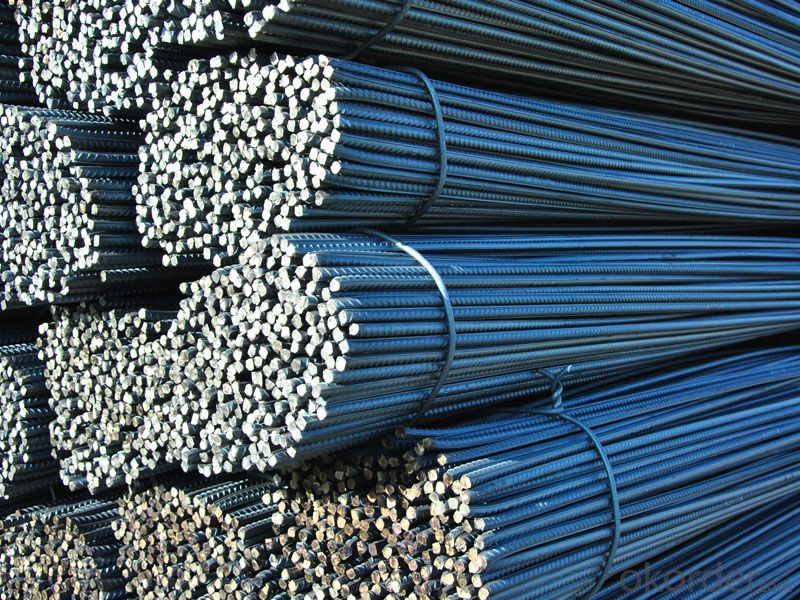
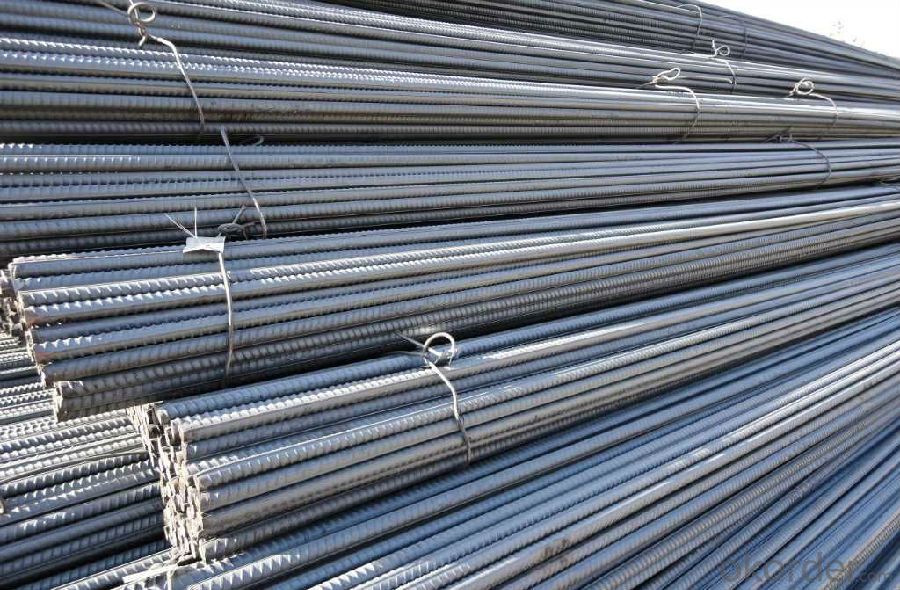
- Q: What are the guidelines for the proper lap splicing of steel rebars?
- The guidelines for the proper lap splicing of steel rebars are as follows: 1. Lap Length: The lap length refers to the minimum distance required for the overlapping of rebars. It is determined based on factors such as bar diameter, strength, and the type of structure. Generally, lap lengths are specified by engineering codes and standards. 2. Cleanliness: Before proceeding with lap splicing, it is essential to ensure that the rebars are free from any dirt, rust, oil, or other contaminants. Any foreign material on the rebar surface can hinder the bond between the overlapping bars. 3. Alignment: The rebars to be spliced must be properly aligned and parallel to each other. Any misalignment can result in a weak splice and compromise the structural integrity of the construction. 4. Overlapping: The overlapping length of rebars should be sufficient to ensure the transfer of loads and maintain the continuity of reinforcement. It is crucial to follow the specified lap length to achieve the required strength and performance of the reinforced concrete structure. 5. Splice Configuration: The type of lap splice configuration depends on the structural requirements and the specific design of the project. Commonly used splice configurations include end-to-end splicing, staggered splicing, and mechanical splices. The selection of the appropriate splice configuration should be in compliance with relevant codes and standards. 6. Splice Preparation: The rebars at the lap splice area should be properly cleaned and prepared. This involves removing any loose rust or scale from the bar surface and providing adequate bond length between the bars. 7. Lap Splice Placement: The lap splice should be positioned at the designated location within the concrete member. It is important to ensure that the splice is not too close to the edge of the concrete element, as this can reduce the cover depth and affect the durability of the structure. 8. Splice Length Variations: In cases where the required lap length is not achievable due to space limitations or other restrictions, approved alternatives such as mechanical splices or welded splices can be considered. However, it is essential to consult the project engineer or designer to ensure compliance with the appropriate guidelines. 9. Quality Control: Proper quality control measures should be implemented during the lap splicing process. This includes monitoring the lap splice length, ensuring proper alignment, and conducting periodic inspections to check for any defects or deficiencies. It is important to note that the above guidelines are general recommendations, and the specific requirements for lap splicing may vary depending on the design specifications, construction codes, and local regulations. Therefore, it is always advisable to consult the project engineer or designer for the precise guidelines applicable to a particular project.
- Q: Can steel rebars be used in foundation structures?
- Yes, steel rebars can be used in foundation structures. Steel rebars are commonly used in reinforced concrete foundations to provide strength and structural integrity. They are used to reinforce the concrete and enhance its load-bearing capacity, making it suitable for supporting heavy structures and resisting forces like earthquakes and soil movement.
- Q: How are steel rebars stored and transported on-site?
- Steel rebars are typically stored on-site in neat, vertical stacks or bundles, secured with binding wire or straps to prevent them from shifting or falling. They are usually placed on a flat and well-drained surface to prevent rusting. When it comes to transportation, rebars are commonly loaded onto trucks or trailers using cranes or forklifts. To ensure safe transportation, they are secured with restraints or tied down to prevent movement or any potential damage.
- Q: How do steel rebars affect the weight of a concrete structure?
- Steel rebars can have a significant impact on the weight of a concrete structure. Rebars, which are typically made of steel, are used to reinforce the concrete and enhance its strength and durability. These rebars are usually placed in the areas of concrete that are under tension, such as the bottom of beams or the middle of slabs. While the steel rebars themselves contribute to the overall weight of the structure, their presence allows for the use of less concrete. By adding reinforcement, the concrete can withstand higher loads and stresses, reducing the need for excessive amounts of concrete. This leads to a lighter structure overall. Additionally, the use of steel rebars enables the design and construction of more slender and efficient structures. The enhanced strength provided by the rebars allows for longer spans and thinner sections, resulting in reduced dead load. This not only reduces the weight of the structure but also allows for more flexibility in architectural and structural design. Moreover, the weight of a concrete structure is a critical consideration, especially in high-rise buildings or long-span structures. Excessive weight can put strain on the foundation and increase construction costs. By utilizing steel rebars, the weight of the concrete structure can be optimized without compromising its structural integrity. In summary, steel rebars play a crucial role in reducing the weight of concrete structures. They allow for the use of less concrete while maintaining the required strength, resulting in lighter and more efficient structures. The use of rebars also provides flexibility in design and reduces construction costs associated with excessive weight.
- Q: Why is the price of screw steel affected by iron ore and coal?
- Just now the manufacturing needs to consume iron ore and gas energy, the cost goes up, the price certainly changes
- Q: What is the recommended method for splicing steel rebars together?
- The recommended method for splicing steel rebars together is typically achieved using mechanical splices or lap splices. Mechanical splices involve connecting two rebars using couplers or sleeves, which are designed to provide strength and stability to the joint. Lap splices, on the other hand, involve overlapping the rebars and securing them together with steel wire or tie bars. The choice of method depends on factors such as the structural requirements, rebar diameter, and construction specifications.
- Q: Can steel rebars be used in cold storage construction?
- Yes, steel rebars can be used in cold storage construction. Steel rebars are commonly used in the construction of cold storage facilities due to their strength, durability, and ability to withstand low temperatures. They provide structural reinforcement to the concrete walls, floors, and ceiling, ensuring the integrity and stability of the cold storage structure. Additionally, steel rebars are resistant to corrosion, which is important in maintaining the longevity of the cold storage facility in a low-temperature environment.
- Q: What are the guidelines for ensuring proper concrete cover over steel rebars?
- The guidelines for ensuring proper concrete cover over steel rebars include: 1. Following the specified cover requirements mentioned in the structural design or building codes. 2. Ensuring that the rebars are placed at the correct depth within the concrete to achieve the desired cover. 3. Using appropriate spacers or chairs to maintain the required distance between the rebars and the formwork during concrete pouring. 4. Ensuring proper consolidation of the concrete to eliminate voids or air pockets around the rebars. 5. Regularly inspecting the concrete cover during construction and taking necessary measures to correct any deficiencies. 6. Protecting the rebars from corrosion by using high-quality concrete with appropriate additives and ensuring proper curing of the concrete. 7. Regular maintenance and inspection of the structure throughout its lifespan to ensure the concrete cover remains intact and provides adequate protection to the rebars.
- Q: What are the guidelines for proper splicing of steel rebars in concrete structures?
- Ensuring the structural integrity and safety of concrete structures requires strict adherence to guidelines for splicing steel rebars. The following are key guidelines to follow: 1. Lap Splicing Length: The overlapping distance between rebars, known as lap splicing length, must adhere to the design plans or structural codes. Typically, minimum lap lengths are specified as a multiple of rebar diameter, such as 40 times for tension members and 25 times for compression members. 2. Cleanliness: Prior to splicing, rebars must be thoroughly cleaned to remove rust, scale, dirt, and other contaminants. Proper cleaning guarantees a strong bond during splicing. 3. Proper Alignment: Rebars to be spliced should be aligned correctly to maintain reinforcement continuity. Misalignment can cause stress concentration and weaken the structure. The bars should be parallel, evenly spaced, and in a straight line. 4. Splice Type: Various splice connections, including lap splicing, mechanical splicing, and welded splicing, are available. The choice of splice type should consider project requirements, structural design, and local building codes. 5. Reinforcement Bar Preparation: Before splicing, rebars should be prepared by removing scale, rust, and other contaminants. This can be achieved through brushing, grinding, or shot blasting. Additionally, the bar ends must be clean and free of deformations or irregularities. 6. Testing and Inspection: Regular testing and inspection are crucial to ensure the quality and integrity of spliced rebars. Non-destructive testing methods like ultrasound or magnetic particle testing can be used to check bond strength and ensure correct splicing. 7. Adequate Cover: Spliced rebars require sufficient concrete cover to protect against corrosion and fire. The concrete cover thickness should comply with local building codes and design specifications. 8. Proper Grouting: When using mechanical splices, ensure proper grouting or filling of splice sleeves or couplers with approved non-shrink grout. This ensures full load transfer and prevents rebars from moving or slipping. 9. Documentation: All splicing activities should be thoroughly documented, including the splice type, lap lengths, inspection reports, and any deviations from the original design. This documentation is important for future reference, maintenance, and regulatory compliance. These guidelines serve as general recommendations, and project-specific requirements and local building codes must always be followed. Consulting a qualified structural engineer or reputable construction professional is vital to ensure the highest standards of safety and compliance.
- Q: How do steel rebars perform in fire-resistant constructions?
- Due to their inherent properties, steel rebars are highly effective in fire-resistant constructions. The utilization of steel rebars in these structures serves to bolster their fire resistance. Steel possesses a high melting point and exhibits exceptional heat transfer properties, rendering it a dependable material in fire scenarios. When subjected to elevated temperatures, steel rebars do not undergo combustion or emit toxic fumes, crucially ensuring the safety of individuals during a fire incident. Furthermore, steel rebars possess a low coefficient of thermal expansion, signifying that they experience minimal expansion when exposed to heat. This characteristic helps to maintain the structural integrity of fire-resistant constructions, thereby averting potential structural failures during a fire. Additionally, steel rebars boast high tensile strength, which significantly contributes to the overall performance of the structure in fire conditions. This strength enables the rebars to withstand the forces generated by the concrete's expansion due to heat, thereby reducing the risk of cracking or spalling. Moreover, steel rebars can be encased in fire-resistant materials like concrete and fireproof coatings to provide an additional layer of protection against fire. This combination of steel and fire-resistant materials produces a robust system that effectively endures high temperatures and prolongs the construction's structural stability in the event of a fire. In conclusion, steel rebars play a vital role in fire-resistant constructions. Their high melting point, low thermal expansion, and exceptional tensile strength make them a dependable choice for enhancing the fire resistance of structures. By incorporating steel rebars into construction designs, the safety and durability of buildings are significantly enhanced, affording occupants valuable time to evacuate and minimizing the potential for structural damage during a fire incident.
Send your message to us
Reinforcing Deformed Steel Bars with Grade HRB400
- Loading Port:
- Tianjin
- Payment Terms:
- TT OR LC
- Min Order Qty:
- 25 m.t.
- Supply Capability:
- 20000 m.t./month
OKorder Service Pledge
OKorder Financial Service
Similar products
Hot products
Hot Searches
Related keywords
